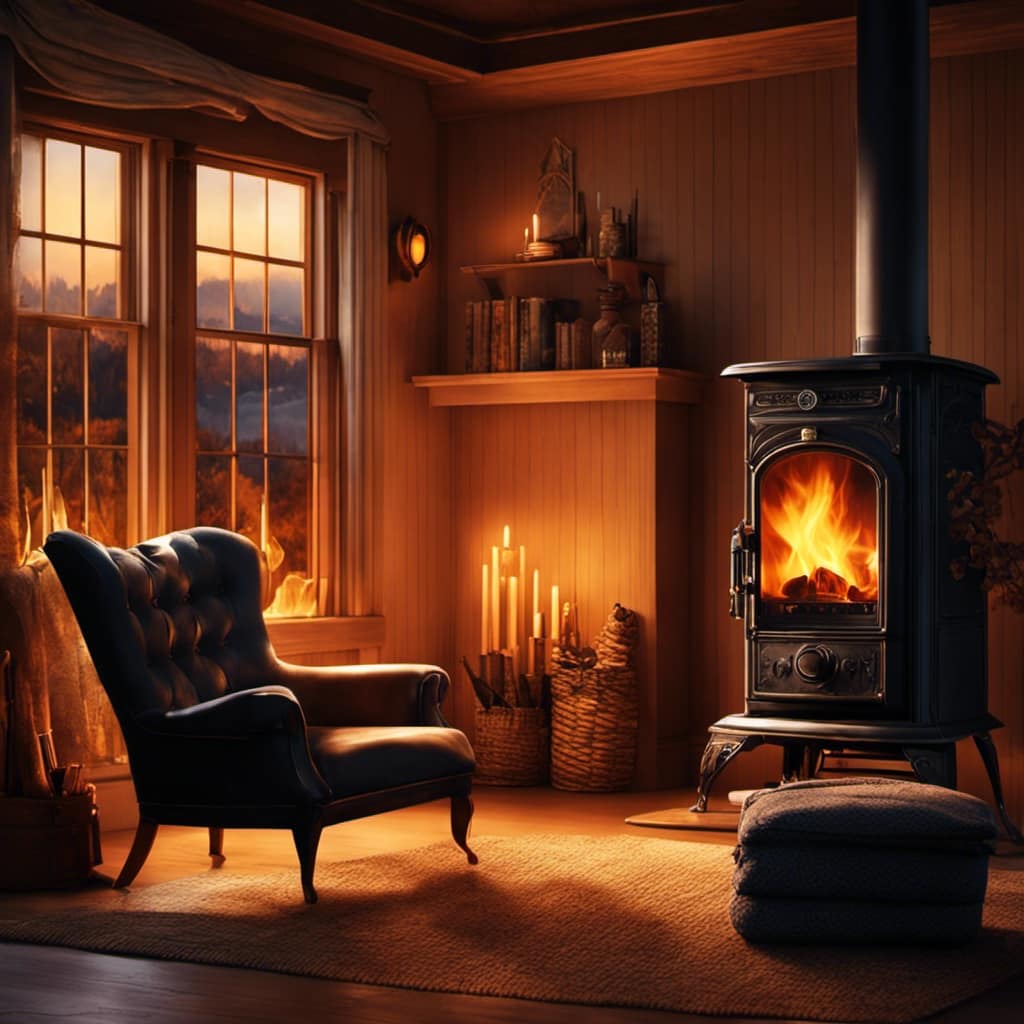
I have always been curious about finding the optimal type of wood for burning in a wood stove. Through thorough research, I have found that the type of wood you use significantly impacts the efficiency of your stove and the amount of heat it produces.
In this article, I’ll share my findings on which woods are most efficient, how to properly prepare and store wood, and even explore the hype around exotic woods.
Get ready to make the most out of your wood stove!
Key Takeaways
- Hardwoods such as oak, maple, and ash are the best types of wood to burn in a wood stove due to their lower moisture content, higher density, and ability to produce more heat for a longer burn time.
- Softwoods like pine, fir, and spruce are practical for quick room warming due to their high resin content, easy ignition, and rapid burn rate.
- Pellets made from compressed sawdust and biomass are a cost-effective and eco-friendly alternative to firewood, offering high heat production and minimal emissions.
- Seasoned wood, which has lower moisture content and has been properly prepared and stored, burns more efficiently, produces more heat, and creates less smoke and air pollution.
Hardwoods: The Top Choice for Efficient Burning
I find that hardwoods are the top choice for efficient burning in a wood stove. When it comes to heating your home, moisture control and heat output are critical factors to consider. Hardwoods, such as oak, maple, and ash, have a lower moisture content compared to softwoods. This means that they burn more efficiently and produce more heat. Hardwoods have a higher density, which allows them to burn longer and provide a steady source of heat throughout the day and night.
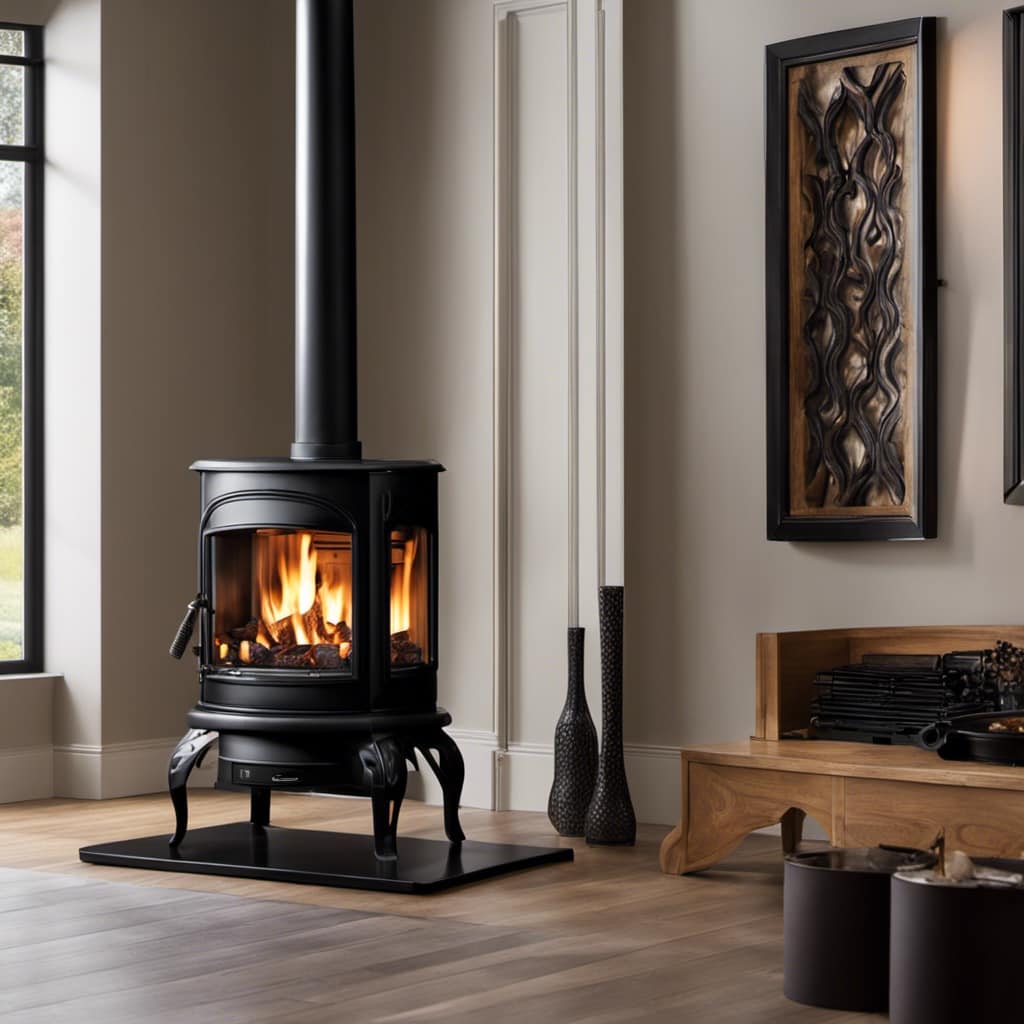
The key to maximizing the heat output of hardwoods is ensuring that they’re properly seasoned or dried. Seasoned hardwoods have a moisture content of around 20%, which is ideal for efficient burning. It’s crucial to store firewood in a dry area and allow it to dry for at least six months to a year before using it in your wood stove.
Transitioning into the subsequent section about softwoods, while hardwoods are excellent for long-lasting heat, softwoods offer a viable option for quick heat.
Softwoods: A Viable Option for Quick Heat
While softwoods may not provide the longest-lasting burn, they’re a viable option for quickly heating up a room. Softwoods, such as pine, fir, and spruce, have a high resin content, which allows them to ignite easily and burn rapidly. This makes them an excellent choice when you need to warm up your space in a hurry.
Softwoods are known for their quick heat production. Due to their lower density compared to hardwoods, they tend to burn faster and release higher amounts of heat in a shorter amount of time. This is particularly beneficial during those cold winter nights when you need immediate warmth.

Although softwoods may not burn as efficiently as hardwoods, they still offer a good source of heat. Their efficient burning is attributed to their resinous nature, which creates a hotter flame and produces significant heat output. This makes softwoods a practical option for those who need to quickly warm up a room or supplement their existing heating system.
It is important to note that softwoods may produce more creosote buildup in your chimney, so regular cleaning and maintenance are necessary to ensure safe and efficient burning. Additionally, the rapid burn rate of softwoods means that you may need to add more logs more frequently compared to hardwoods.
Pellets: The Eco-Friendly Alternative
Pellets are an excellent choice for those seeking an eco-friendly alternative to traditional firewood. Made from compressed sawdust and other biomass materials, pellets are highly efficient and produce minimal emissions.
In addition to being a sustainable fuel source, pellets also offer the convenience of easy storage and clean combustion, making them a popular option for heating homes in an environmentally conscious way.
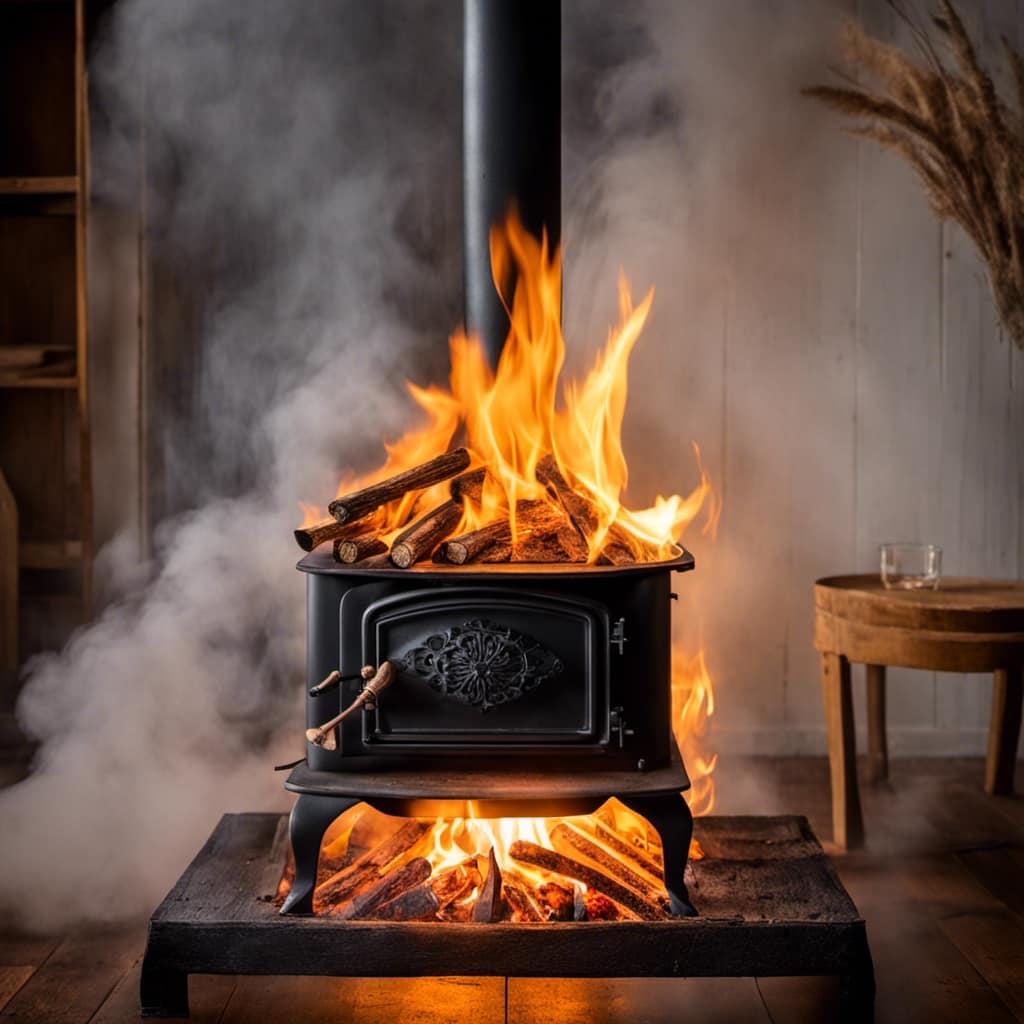
Pellet Benefits Over Firewood
Using pellets instead of firewood for my wood stove offers several advantages.
One major benefit is the cost. Pellets are generally cheaper than firewood, making them a more cost-effective option for heating my home.
Additionally, pellet stoves are known for their efficiency. They burn at a higher temperature and produce more heat compared to traditional wood stoves. This means that I can heat my home more effectively and efficiently, saving both energy and money.
Furthermore, pellet stoves are easy to use and maintain. They require less cleaning and produce less ash and smoke, resulting in a cleaner and healthier indoor environment.
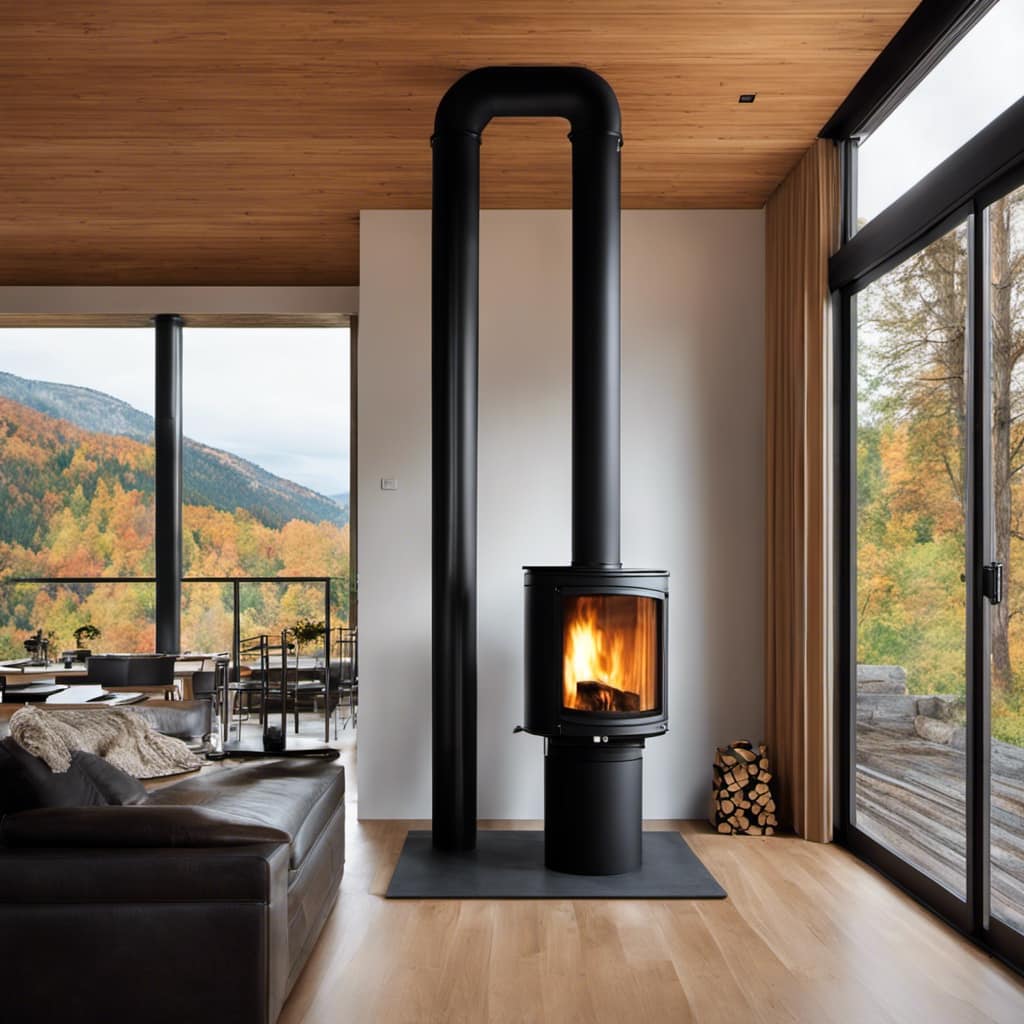
Overall, using pellets in my wood stove not only saves me money and energy but also provides a more efficient and convenient heating option.
Transitioning to the next section, let’s explore the eco-friendly benefits of using pellet stoves.
Eco-Friendly Heating Option
I find that using pellet stoves is a greener and more environmentally friendly way to heat my home. Pellet stoves are an excellent option for eco-friendly heating, as they use sustainable fuel sources. These stoves burn small, compressed wood pellets made from sawdust and other biomass materials.
The pellets are produced from renewable resources, such as wood waste from lumber mills or agricultural byproducts. By using these sustainable fuel sources, pellet stoves help reduce our dependence on fossil fuels and contribute to a cleaner environment.
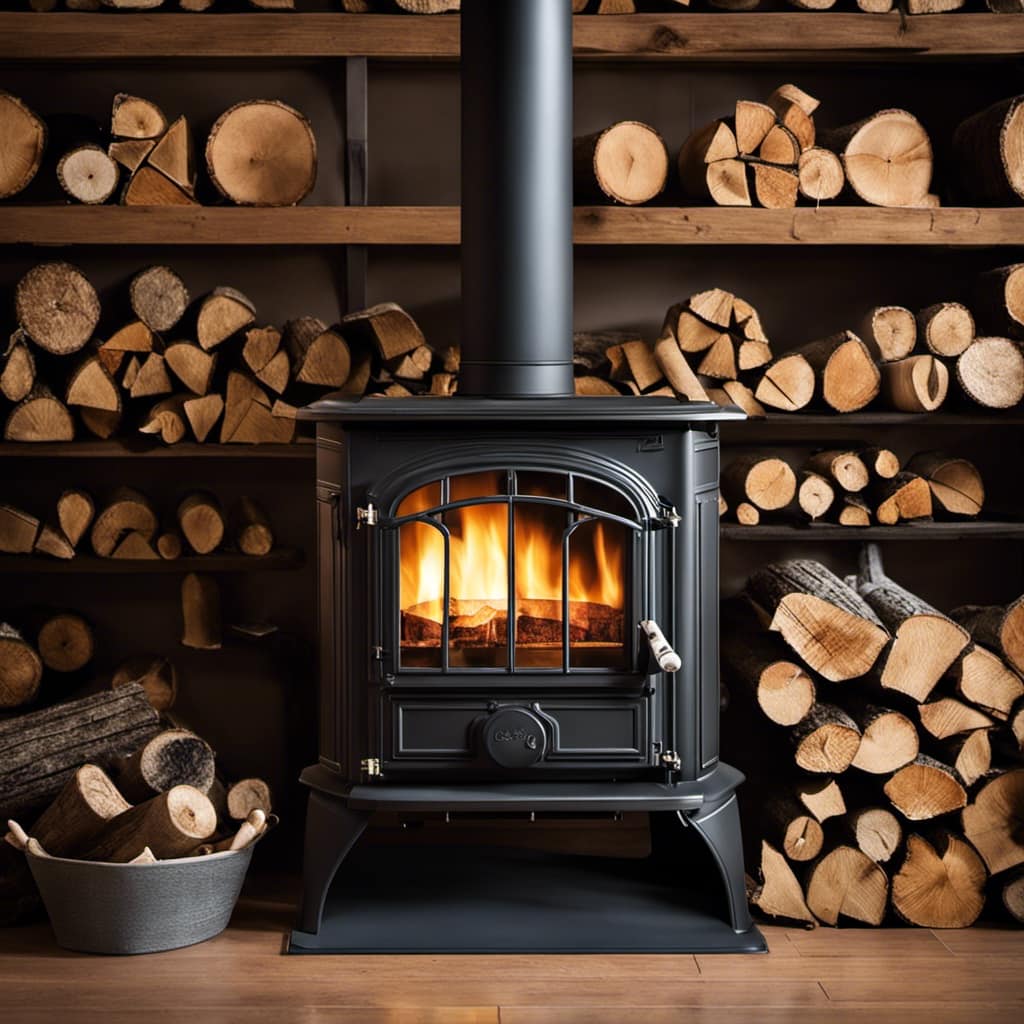
Additionally, pellet stoves have high combustion efficiency, meaning they produce less smoke and emit fewer pollutants compared to traditional wood-burning stoves. This makes them an ideal choice for those who are environmentally conscious and want to reduce their carbon footprint.
Now, let’s explore the difference between seasoned and green wood and which one burns better.
Seasoned Vs. Green Wood: Which Burns Better
In my experience, seasoned wood tends to burn much better in a wood stove compared to green wood. Seasoned wood refers to wood that has been properly dried out, usually for at least six months to a year. On the other hand, green wood is freshly cut and has a higher moisture content.
The benefits of burning seasoned wood are numerous. First and foremost, seasoned wood burns more efficiently and produces more heat. This is because the moisture in green wood needs to evaporate before the wood can ignite and burn. This process takes up a significant amount of energy and reduces the overall heat output. In contrast, seasoned wood has a lower moisture content, allowing it to ignite faster and produce a hotter flame.

Additionally, burning seasoned wood results in less creosote buildup in the chimney. Creosote is a highly flammable substance that can accumulate when wood is burned inefficiently. By using seasoned wood, which burns more efficiently, the amount of creosote produced is significantly reduced, minimizing the risk of chimney fires.
Lastly, seasoned wood creates less smoke and air pollution. Green wood tends to produce more smoke due to its higher moisture content. This not only affects air quality but can also cause respiratory issues for those living nearby. By opting for seasoned wood, you can enjoy a cleaner, healthier burn in your wood stove.
Splitting and Storing: Tips for Proper Wood Preparation
When it comes to proper wood preparation, splitting and storing are two key factors to consider. As someone who’s been burning wood for years, I can confidently say that these steps are crucial for optimal burning efficiency.
Moisture Content Importance
Having a low moisture content in the wood is crucial for efficient and effective burning in a wood stove. One way to determine the moisture content of the wood is through moisture content testing. This involves using a moisture meter to measure the amount of moisture present in the wood.
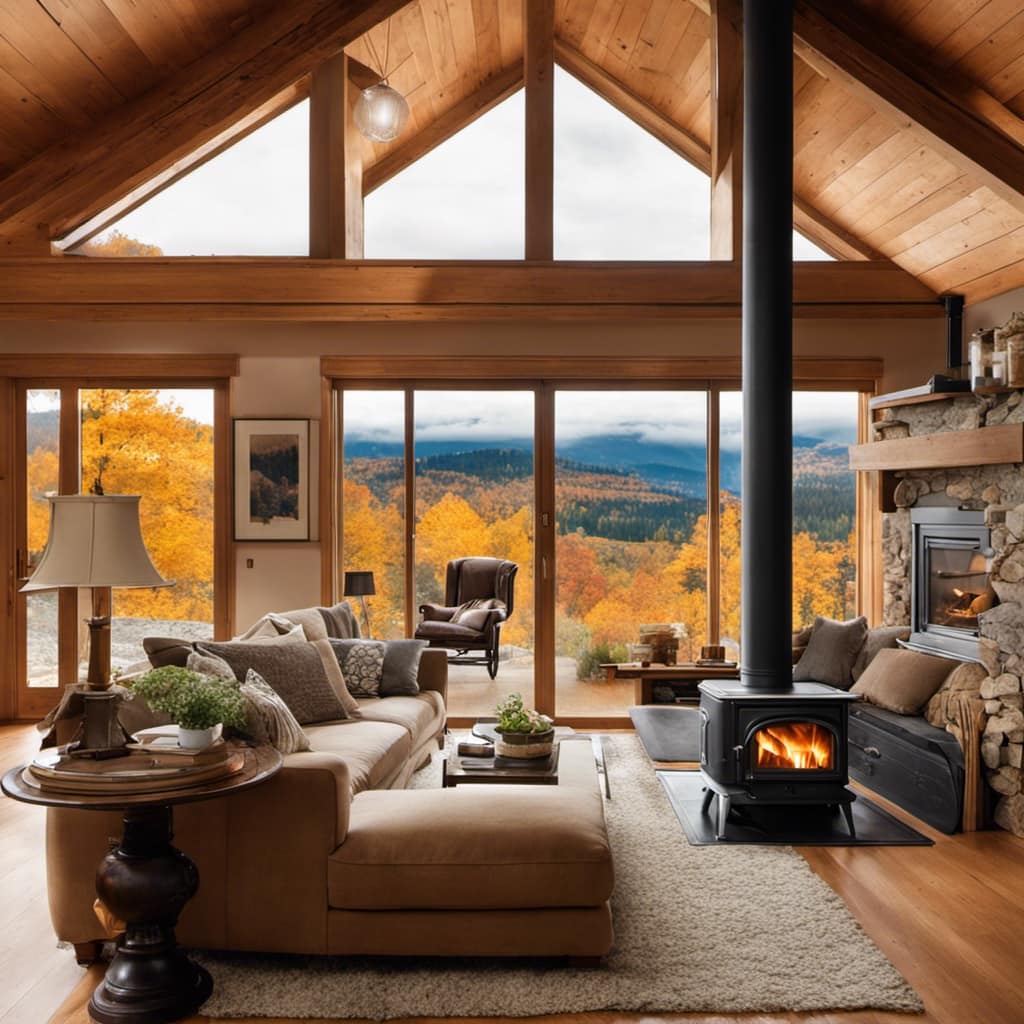
It’s recommended to have a moisture content of around 20% or less for optimal burning. If the wood has a higher moisture content, it will take longer to ignite and produce less heat.
To reduce the moisture content, there are various drying techniques that can be employed. These include air drying, kiln drying, and using a wood moisture meter to monitor the progress. Air drying involves stacking the wood and allowing it to naturally dry over time. Kiln drying, on the other hand, uses a controlled environment to speed up the drying process.
Splitting Techniques for Efficiency
I find that using a maul and wedge is the most efficient way to split firewood. When it comes to maximizing wood stove performance, efficient splitting techniques are crucial.
Here are four reasons why using a maul and wedge is the way to go:
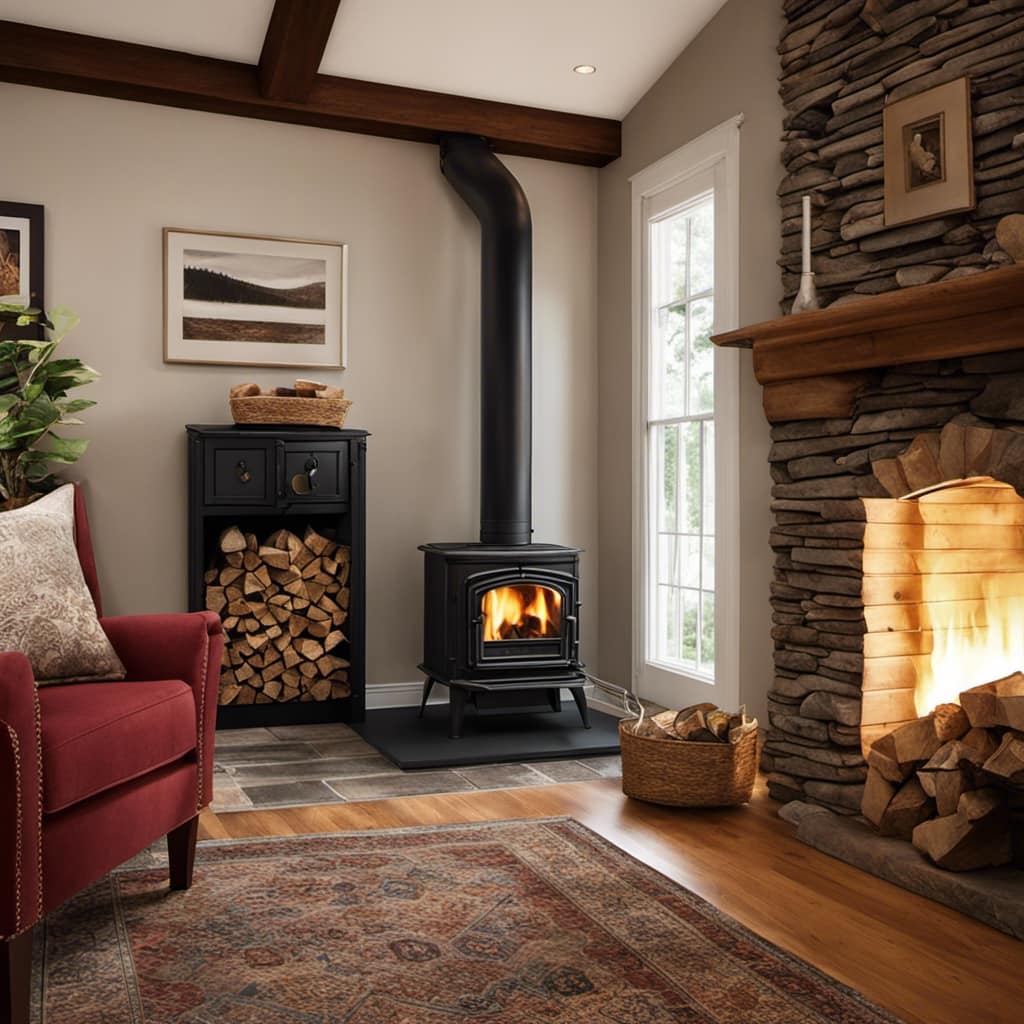
-
Power: The weight of a maul combined with the force of a swing delivers a powerful blow, making it easier to split even the toughest logs.
-
Precision: The sharp edge of the wedge allows for precise placement and accurate splitting, ensuring clean and consistent splits.
-
Control: With a maul and wedge, you’ve better control over the splitting process, allowing you to adjust your technique to different types and sizes of wood.
-
Efficiency: Splitting wood with a maul and wedge is faster and requires less effort compared to other methods, saving you time and energy.

Proper Wood Storage
Properly stacking firewood ensures its longevity and prevents rot. When it comes to wood stacking, there are a few important factors to consider, with moisture control being a top priority. The key is to elevate the wood off the ground, allowing air circulation to prevent moisture accumulation.
Start by creating a sturdy base, using pallets or concrete blocks. Next, stack the wood in a crisscross pattern, alternating the direction of each layer. This creates stability and allows for better airflow. It’s also crucial to leave space between the stacked logs, promoting ventilation and reducing the chances of mold growth.
Lastly, cover the top of the stack with a tarp, leaving the sides open to ensure proper ventilation. By following these wood stacking techniques and controlling moisture, you can ensure the longevity and quality of your firewood.
Exotic Woods: Are They Worth the Hype?
In my experience, exotic woods may not be worth the hype when it comes to burning in a wood stove. While they may seem appealing due to their unique and vibrant colors, there are several factors to consider before opting for exotic woods as your primary fuel source.

Here are the pros and cons, as well as the cost effectiveness of using exotic woods:
- Pros:
- Exotic woods can create a mesmerizing flame display, with different hues of red, orange, and blue dancing in the fire.
- They often emit a pleasant aroma when burned, adding a touch of fragrance to your home.
- Exotic woods can be a conversation starter, as guests will be intrigued by the unusual colors and patterns in the fire.
- Some exotic woods, such as sandalwood, are known for their potential health benefits, like stress reduction and improved sleep.
- Cons:
- Exotic woods are generally more expensive than traditional firewood options, making them less cost-effective in the long run.
- They may be harder to find and obtain, requiring extensive research and potentially increasing transportation costs.
- Exotic woods can be more challenging to ignite and maintain a consistent burn, requiring more attention and effort.
- Some exotic woods, like ebony or rosewood, may release toxic fumes when burned, posing health risks.
Considering the pros and cons, it’s essential to weigh the aesthetic appeal and potential health benefits against the higher cost and potential difficulties associated with burning exotic woods in a wood stove. Ultimately, it’s a personal choice that depends on your preferences and priorities.
Frequently Asked Questions
Can I Burn Treated or Painted Wood in a Wood Stove?
I wouldn’t recommend burning treated or painted wood in a wood stove.
There are safety concerns when it comes to burning these types of wood. Treated wood often contains chemicals that can release toxic fumes when burned, posing a health risk. Painted wood can also release harmful chemicals when burned.

It’s best to stick to dry, seasoned, and untreated wood for optimal safety and efficiency when using a wood stove.
How Often Should I Clean My Wood Stove and Chimney?
When it comes to properly maintaining a wood stove and chimney, regular cleaning is essential. Cleaning frequency depends on how often you use the stove, but it’s recommended to clean it at least once a year.
Regular maintenance not only improves the efficiency of your wood stove but also reduces the risk of chimney fires and ensures safe operation.
Are There Any Health Risks Associated With Burning Wood in a Wood Stove?
When it comes to burning wood in a wood stove, it’s important to consider the health benefits and environmental impact.

Wood burning can release harmful pollutants into the air, such as particulate matter and carbon monoxide, which can have negative effects on respiratory health. However, burning seasoned hardwoods with low moisture content can minimize these risks.
Additionally, using a properly maintained wood stove and ensuring good ventilation can help reduce indoor air pollution.
Can I Burn Wood That Has Been Infested by Insects?
Burning infested wood in a wood stove can be risky. It’s like inviting unwanted guests to a party. Not only can it release harmful chemicals into the air, but it can also damage your stove and chimney.
Wood stove safety is crucial, so it’s best to avoid burning wood that has been infested by insects. Stick to using dry, seasoned wood for a safer and more efficient burn.
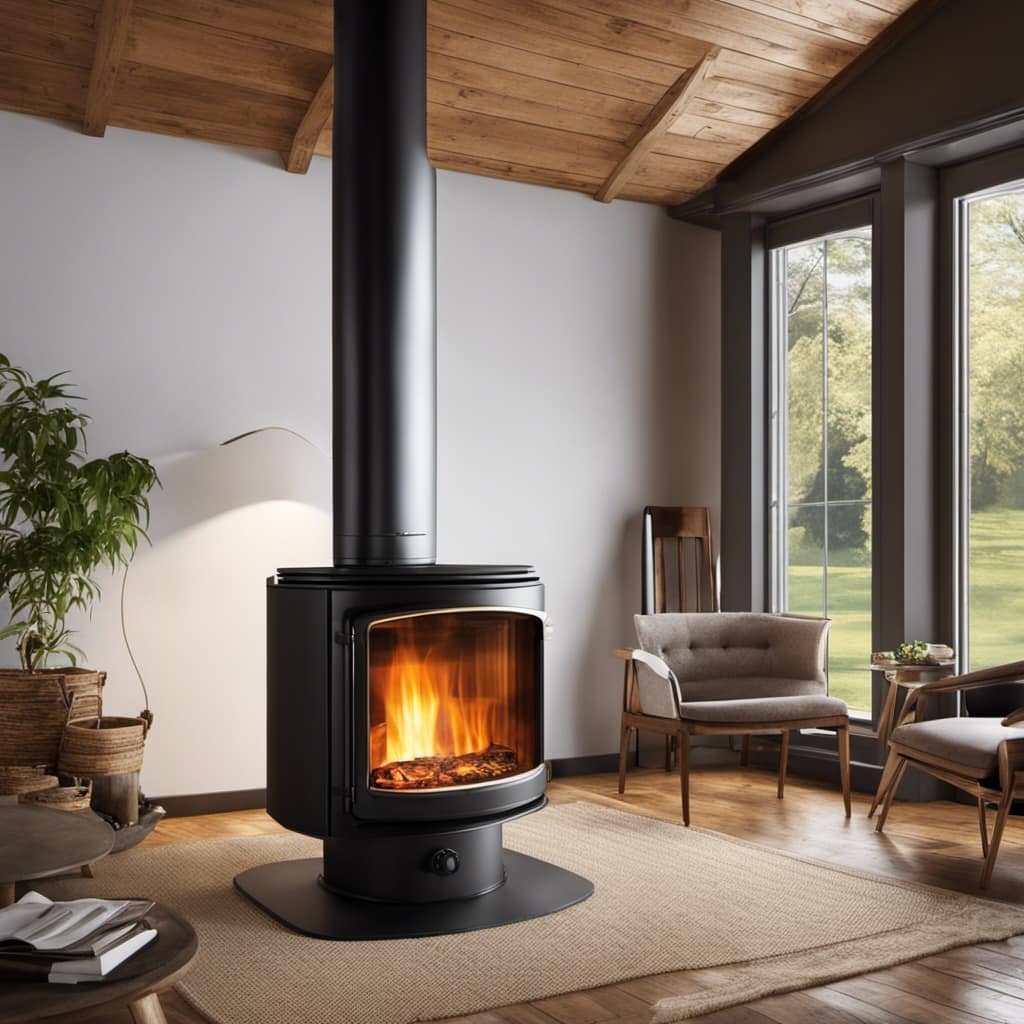
What Are the Best Practices for Starting and Maintaining a Fire in a Wood Stove?
When it comes to starting and maintaining a fire in a wood stove, there are a few tips that can greatly improve efficiency.
First, make sure you’ve properly seasoned firewood. This means allowing the wood to dry for at least six months before burning it. Dry wood burns hotter and produces less smoke.
Additionally, using smaller pieces of wood and arranging them in a crisscross pattern can help air circulate better and create a more efficient burn.
Conclusion
After careful research and analysis, it’s clear that hardwoods reign supreme as the best wood to burn in a wood stove. Their efficiency and long burn times make them the top choice for those seeking warmth and cost-effectiveness.
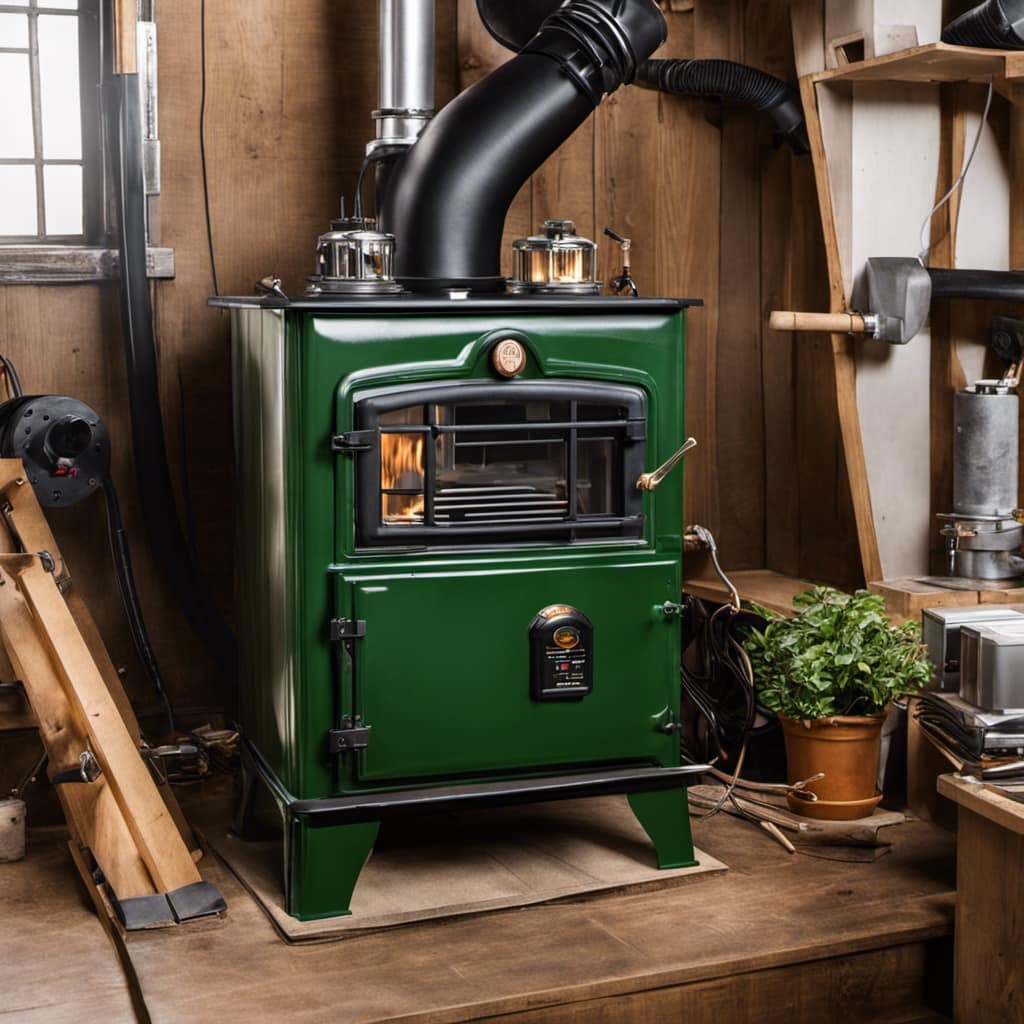
Softwoods may offer quick heat, but they lack the endurance and energy efficiency of hardwoods.
Pellets, on the other hand, provide an eco-friendly alternative for environmentally conscious individuals.
Ultimately, seasoned wood and proper preparation are key factors in achieving optimal burning performance.
Exotic woods may sound enticing, but the benefits they offer may not justify the hype.
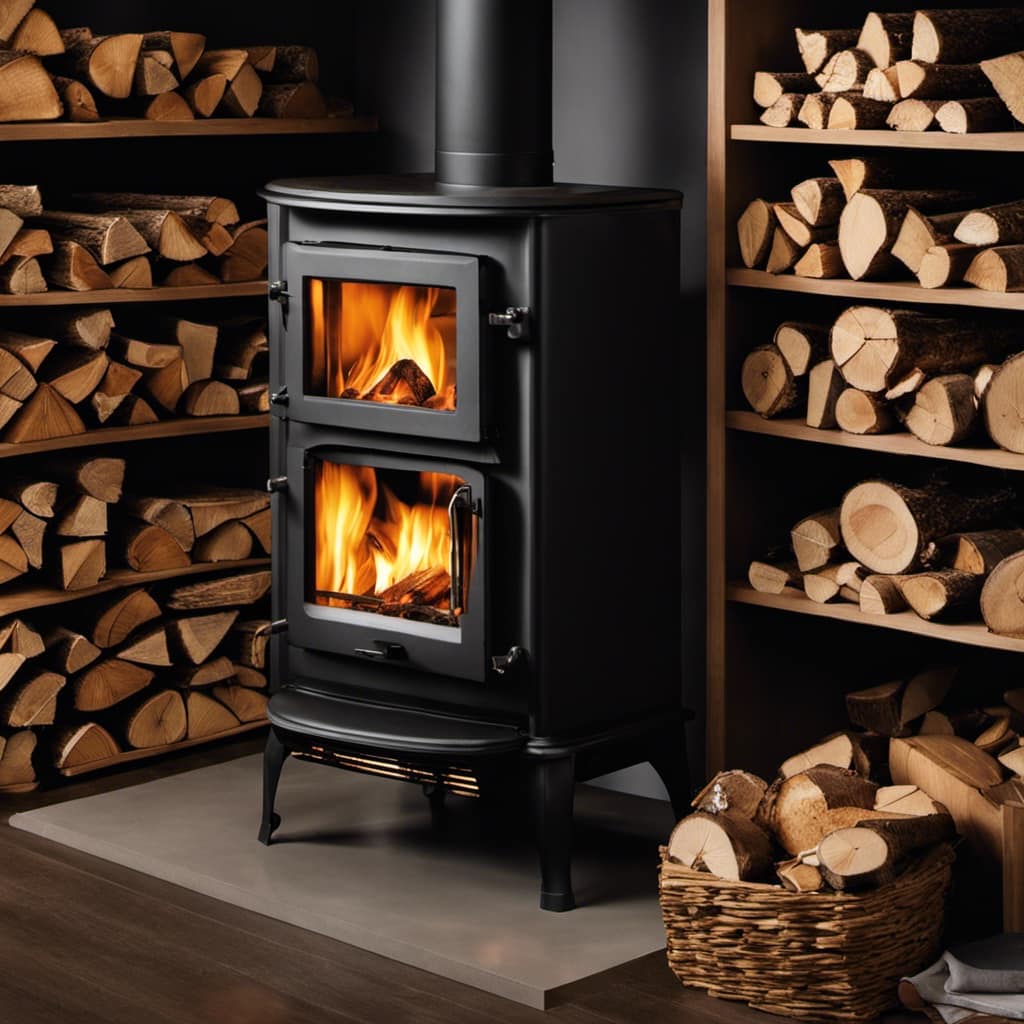
Growing up surrounded by the vast beauty of nature, Sierra was always drawn to the call of the wild. While others sought the comfort of the familiar, she ventured out, embracing the unpredictable and finding stories in the heartbeat of nature.
At the epicenter of every remarkable venture lies a dynamic team—a fusion of diverse talents, visions, and passions. The essence of Best Small Wood Stoves is crafted and refined by such a trio: Sierra, Logan, and Terra. Their collective expertise has transformed the platform into a leading authority on small wood stoves, radiating warmth and knowledge in equal measure.











